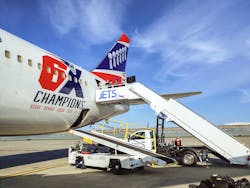A Passenger Stairway for Larger Aircraft
Already having a smaller model of chassis-mounted boarding stairs in its portfolio, the design for Stinar’s SPS-3518 model was inspired by customer requests for stairs that could service larger aircraft.
Stinar’s SPS-3518 Passenger Stairway reaches boarding doors with sill heights of 96 to 228 inches. That means it’s compatible with aircraft the size of the A300, A320, A340 and B777 and the lower doors of the A380, offering a passenger boarding solution at areas other than terminals equipped with jet bridges.
“It's functional in that it opens up services that otherwise may not have been attainable with the current facilities operators have now,” says Stinar CEO Craig Kruckeberg. “A mobile boarding stair has many benefits when it comes to air travel.”
The SPS-3518 Passenger Stairway uses a hydraulic lift system operated by the commercial chassis PTO. The telescoping stairway consists of two stair sections supported by an A-frame with an integral ratcheting system. The lower stair section is stationary while the upper stair section telescopes into position and features an ergonomic front-boarding deck with extension platform, swivel bumper and proximity safety sensors.
Dual controls are located in the chassis cab and on the boarding platform. Inside the cabin, controls are used to raise and lower the stairs, adjust the A-frame, and raise and lower the stabilizers at the front, middle and rear of the chassis.
Lowering the A-frame also requires releasing the A-frame lock release switch. This actuates an electric solenoid, which releases the A-frame ratchet — a mechanical lock that prevents the A-frame from being lowered unless the switch is engaged.
At the top of the stairs, on the boarding platform, controls adjust the A-frame and stairs as well as extend the platform, which is 83 inches long (133 inches long with the landing) and 72 inches wide.
Attached to the underside of the platform is a camera to allow adjustments of the platform to the correct door height of the aircraft. The camera’s video can be viewed from a monitor inside the cab.
Safety features include cab warning lights that indicate stabilizer position, a backup camera and an amber flashing beacon. What’s more, in the event that the hydraulic system fails, there’s an emergency power pack. If the emergency power pack fails, there’s an emergency hand pump.
“Numerous safety measures have been added in the form of proximity sensors, safety alarms, checks and integral measures that must be done for the stair to operate as designed,” Kruckeberg says.
“We provide onsite product training for each new unit purchased and will come and train new employees on older units in the field for customers looking for refresher training. We’ve gone to great lengths to make assure all equipment, planes, operators' and customers' safety is priority number one for Stinar units.”
Other key features, according to Kruckeberg, include lock valves on all hydraulic cylinders, an integrated ratchet system, multi-functional stabilizers with pressure sensors and heavy-duty OEM cab/chassis capable of supporting the boarding unit and the passengers on the boarding system.
After the SPS-3518 was introduced in February 1984, customers made requests for options. Today many of those requests are now standard on the equipment.
“We’ve taken most of those options and made them standard, expanded on them some, added additional features and offer a fully loaded passenger boarding stair,” Kruckeberg says.
According to Kruckeberg, key options available to customers today are the color of the stair unit, OEM chassis make, and OEM engine (diesel or gas).
“We are looking to add EV options as well,” he says.
“Several updates were made with more being integrated as Stinar continually builds out units for customers and tweaks the little things they want to make better,” Kruckeberg adds.
Today, the SPS-3518 is in use all over the world, from commercial airports and FBOs to government bases and foreign operations. Customers include ground handlers, airlines and airports, but of late Kruckeberg says the biggest users of the passenger stairs have been ground handlers and FBOs that are expanding their charter services.
Customers love it, in part, he says, because it’s very easy to operate, and they have many positive comments.
In addition to the SPS-3518, Stinar’s current passenger boarding stair lineup includes the SPS-6018, SPS-6018evf, SPS-5519/SPS-7026 and PS-813B/E. All are telescoping boarding stairs. The drivable units utilize an OEM cab/chassis and they all are designed, built and warrantied by Stinar. The difference lies in boarding stair widths. Units that specialize in ARFF operations are SPS-6018 and SPS-6018evf, units designed for government/military use are SPS-5519 and SPS-7026, and Stinar’s most recognizable unit for commercial use (SPS-3518) has a towable version (PS-813B/E).
“From design to manufacturing, our team at Stinar stands behind each unit that is rolled out our doors. From holding tight tolerances to following the ICAO and IATA recommendations on our units, meticulous thought goes into each of our parts. From utilizing premier Class 5 OEM chassis to assuring our machined lock valves are thoroughly tested, the product we put out is backed by an industry-leading warranty for a reason,” Kruckeberg says.
When ground service providers are selecting stairs for their operation, Stinar officials recommend considering the location of boarding, the personnel dedicated to passenger boarding, a facility's features, options for refueling and the type of aircraft being serviced.
“If they are looking at a towable unit, do they have the equipment to pull the stairs?” Kruckeberg offers as an example, adding frequency and quantity of passenger boarding play a key role in considerations. “If they are doing multiple boardings per day, in several different spots, adequate equipment like our SPS-3518 will be key to them.”
Stinar officials also note their stairs offer options that can help ground handlers navigate the challenges associated with specific geographic locations, climates, traffic volumes and other needs. How can geographic location, climate, traffic volume, etc., influence a customer’s need when making a selection?
“Their primary thing to consider is the fueling of the vehicle and the type of fuel available to them,” Kruckeberg says.
According to Kruckeberg, normal care and maintenance goes a long way in keeping equipment such as passenger stairs in good working condition.
“We provide an operations/maintenance manual with a full rundown of preventive maintenance and frequency to those PMs. Grease is a good thing when it comes to our stairs, each zerk is labeled for the operator's team to provide adequate care,” he says. “Regular cleaning, preventive maintenance and proper operations will keep your SPS-3518 lasting many, many years.”
About the Author
Rebecca Kanable
Assistant Editor
Rebecca Kanable, a veteran journalist, worked with Endeavor Business Media's aviation group from 2021 to 2024 as assistant editor of Airport Business, AMT and Ground Support Worldwide. She previously worked for various publications, including trade magazines and newspapers.

